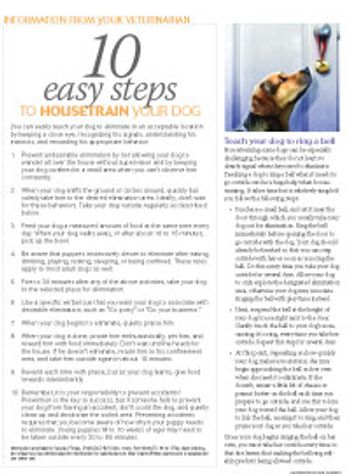
Careful observation can provide veterinarians and owners clues about how a dog may react in specific situations.

Careful observation can provide veterinarians and owners clues about how a dog may react in specific situations.

Use this handout to talk to clients about what good healthcare means for their cat-in the veterinary hospital and at home.

Listen as Dr. Ilona Rodan offers examples and tips to make cats more comfortable at your practice and reduce their fear of the veterinarian.

Listen as Dr. Ilona Rodan stresses the importance of asking your clients to look beyond old age as an explanation for pain in cats.

Hear all about a study that investigated whether cats could distinguish their owners' voices from those of strangers.

This study set out to determine if cats have the ability to distinguish between the voices of their owners and strangers.

If you prescribe one of these two antianxiety drugs, make sure your clients know all they need to know by giving them this handout.

For some behavior patients, the anti-anxiety effects of a single drug might not be enough. In cases in which monotherapy is insufficient, consider adding one of these drugs to your treatment plan.

A reader's response to "Just Ask the Expert: Inhibiting a Lab's infatuation with its toy ball" in the November 2013 issue.

Research suggests that neutering may help modulate unwanted behaviors and eliminate or reduce the risk of some diseases-but exacerbate other health issues. So consider the favorable and adverse effects of neutering to help veterinary clients make informed decisions.

The AVMA offers tips on how to prevent holiday hazards from harming family pets.

This handout gives pet owners tips to successfully train their dog to eliminate in an acceptable location.

dvm360 Medicine Channel Director Mindy Valcarcel admits what she didn't know about cats-and what your clients may not know either.

A recent study examined whether young puppies that attend socialization classes are really at an increased risk for this deadly viral disease.

Trainer Mike Ritland cultivates a unique combination of olfactory skill and hunt drive in special forces canines.

In part 2 of this series, we equip veterinary teams to assess and alleviate fear during veterinary visits to build a more behavior-centered practice-and stronger pet-owner relationships.

Devoicing and debeaking are complex veterinary surgical procedures performed on roosters to keep them from making noise and fighting. Dr. Eric Klaphake offers his views on these techniques and how to explain them to clients.

Encourage clients to try behavior modification to deal with a scratching kitten.

In part 1 of this two-part series, new research explores the dramatic impact of a single veterinary visit on a pet's long-term behavioral well being.

Dr. Lisa Radosta presents three tools you can use to help pets be on their best behavior.

These three simple tips can make or break a veterinary client's behavior modification training session.

Behaviorist Dr. Sophia Yin offers an important tip, brought to you by dvm360's Kristi Reimer.

PETA contends it's offering humane option for animals turned away by no-kill shelters.

New study finds the bond between mother and child is similar to puppy and owner relationship

A trip to the veterinarian can be a scary experience for pets-and their owners. Turn it into a positive one by focusing on animal behavior and catering to pets' needs.